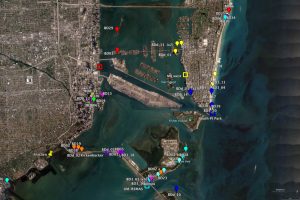CARTHE Concludes Year One of Bay Drift Citizen Science Project
– SEPTEMBER 26, 2017
(From Summer 2017 Newsletter) The Consortium for Advanced Research on Transport of Hydrocarbon in the Environment (CARTHE) recently concluded a year-long citizen science project called the Biscayne Bay Drift Card Study (or Bay Drift), which began last September to better understand the marine debris problem in Biscayne Bay. CARTHE partnered with local organizations including the Vizcaya Museum and Gardens; Frost Science; the University of Miami; and several other nonprofits, government agencies, and local schools, to launch quarterly deployments of drift cards and GPS-equipped biodegradable drifters to track currents and to provide information to resource managers on circulation patterns in the bay. A full list of the project partners can be found here.
Over 20 CARTHE drifters and 1,200 small wooden drift cards were released throughout the year, in September 2016, December 2016, February 2017, and April 2017. Nearly 100 cards were recovered and reported via email or Instagram using the hashtag #BayDrift. The vast majority of GPS drifters remained inside the bay with only a few leaving and entering into the Gulf Stream. This indicated that there is a long residence time for material inside the bay and few opportunities for escape. The drift cards and drifters clearly showed the tidal impact on debris, looping back and forth in certain areas and landing on different beaches based on the tides during the time of the release. More research needs to be done to identify possible sources of the debris.
Through this work, CARTHE provided drifters and information to the Miami Dade County’s Department of Environmental Resource Management (DERM) when a sewer pipe broke and began leaking on June 20, 2017. CARTHE’s drifters provided the county with data on where the contamination from the leak may be going so they could test the waters and issue the appropriate advisories to the community.
“One of the most important aspects of this project is that it is a true community collaboration. We were surprised and delighted with the positive response we have received from the citizen scientists who now understand how important this research is,” said Laura Bracken, CARTHE Program and Outreach Manager.
By collaborating with 12 organizations and enlisting the help of 12 local school groups, the study has reached over 1,000 individuals, teaching them about the importance of studying and protecting the local environment. Students helped by drawing pictures or writing poems on the cards (which makes them more likely to be picked up and reported) and by launching the drifters and drift cards from designated areas across the bay.
The Bay Drift Project was so successful that CARTHE and their partners will be continuing it for another year! At an event on August 13 at the Vizcaya Museum and Gardens, all involved celebrated their successes, shared what was learned in the first year of the project, and kicked off the second year. Photos from that event can be found on CARTHE’s Facebook page here.
More information on the Bay Drift Project can be found here, here, and here.







